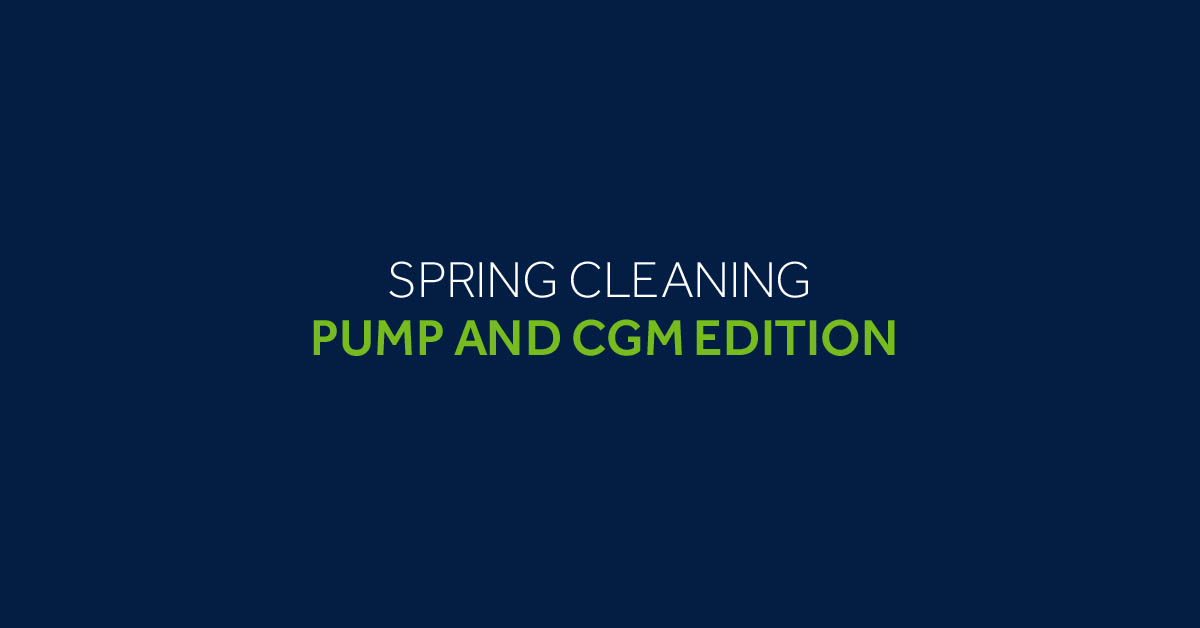Spring cleaning: Pump and CGM edition

Editor’s Note: Welcome to Spring! While many people are going through and cleaning their houses, we thought spring cleaning was a great time to look at how to clean your pump and CGM. We had a lot of great feedback on Naomi’s blogs on cleaning your insulin pump and CGM, and wanted to share them here with you again!
Spring cleaning is the time of year when we tend to clean up our surroundings to simplify our lives after the dreary winter months. Depending on where you live, you may be coming out of the cold soon and, with the sight of some new blooms, ready to take on your closet or your kitchen cabinets. But how about organizing your pump supplies or cleaning your insulin pump?
My pump typically stays pretty clean because it has a cute pump skin or bedazzled case around it, but there have been times I’ve needed to clean it after an accidental squirt of sun tan lotion and an occasional splash of spaghetti sauce. So in times such as this, according to the MiniMed 530G System User Guide, here’s how to clean your pump if an occasion comes up that you may want or need to clean it.
Before we learn what to do, let’s look at what not to do.
Do not try to clean your pump with the following:
1. Organic solvents like lighter fluid, nail polish remover, paint thinner or lubricants
2. Household items like Windex, 409, cleaning sprays or lotions, or hand sanitizer
Instead:
1. Wash your hands thoroughly.
2. Dampen a cloth with water mixed with a mild detergent to wipe clean the outside of your pump. Do not place your pump under running water or submerge it into any liquid.
3. Wipe the pump to remove any detergent residue with a clean cloth dampened with water.
4. Dry with a clean cloth.
5. Keep the reservoir compartment and battery compartment dry and away from moisture at all times.
6. Use a 70 percent alcohol wipe to disinfect your pump.
7. Use a dry clean cotton tip to remove any battery residue from the battery cap.
8. Use a dry clean cloth to remove any battery residue from the battery compartment opening.
So now along with the growing green trees and flowers that are springing up, not only will your house be clean but so will your pump. It’s as easy as that!
Now that we’ve taken a look at how to clean the pump, what about your CGM? My transmitter and sensor insertion device (also called the Enlite Serter) could definitely benefit from some cleaning! According to the Enlite Serter User Guide, here’s how:
Cleaning the Enlite Serter:
1. Wash your hands thoroughly.
2. Prepare a mild liquid soap solution of 1 teaspoon of soap per 1 gallon of tap water.
3. Rinse the Serter under room temperature tap water for at least one minute.
4. While rinsing, press and release the mechanism on the underside of the Serter to ensure the Serter is completely rinsed with water.
5. Submerge the Serter in the mild soap solution and soak for at least 10 minutes.
6. Brush the entire surface of the Serter with a soft-bristled toddler toothbrush until visibly clean, making sure to pay attention to brushing the hard-to-reach areas.
7. Rince the Serter with room temperature water until all visible soap is gone.
8. Shake off any excess water and place the Serter upright on a clean, dry, cloth to air-dry.
Cleaning the Transmitter:
1. Wash your hands thoroughly.
2. Be careful when you are doing this and remember that the charger, transmitter or tester are not water-tight by themselves so do not dunk any of the sensor components in water. (Recent test plugs have been made watertight, if you think your test plug is, we recommend checking the User Guide that was sent with your transmitter for cleaning instructions).
3. Attach the tester to the transmitter to make sure that water, disinfectant, and alcohol do not get inside the connector. (Not sure what the tester is? It’s the “test plug” used to troubleshoot your transmitter with the 24-Hour HelpLine as well as giving you the ability to plug it up so foreign objects don’t enter it in cases like cleaning.)
4. Dampen a clean cloth with mild liquid soap and warm water. Wipe the outside of the transmitter.
5. Rinse the transmitter under warm tap water but do not get water inside the connector. If you get water inside the connector, shake the water out and allow it to air dry.
6. Using an antibacterial hand-sanitizer on a clean, dry cloth, wipe the transmitter’s surface. Make sure that you do not get any hand-sanitizer inside the connector.
7. Disconnect the tester from the transmitter.
8. Place the transmitter on a clean, dry cloth and air dry for 2-3 minutes.
Now that I have the steps, I am definitely going to do this as well. Good luck on your spring cleaning adventures, I hope this helped!
For more support with your pump, sensor, transmitter and other products, visit Customer Support on our website.


